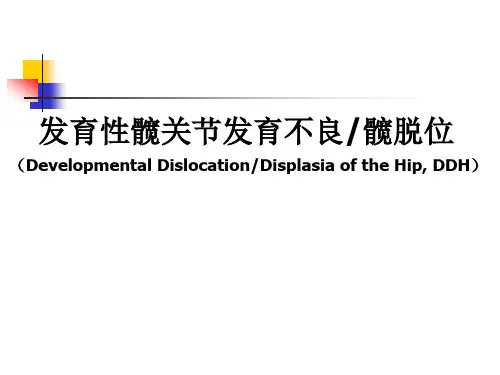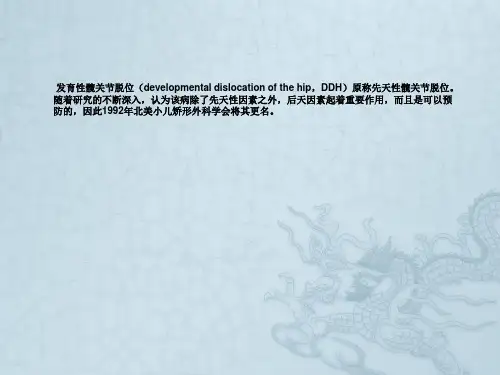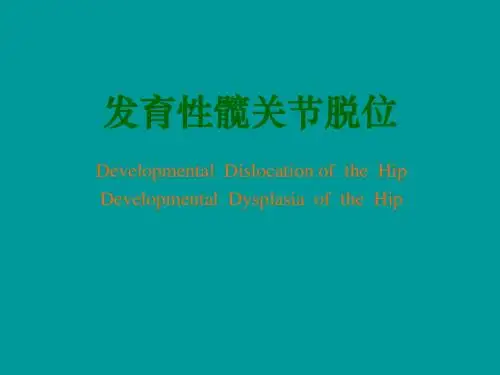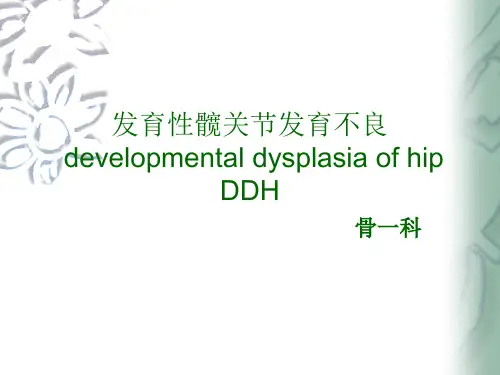133-发育性髋关节脱位(英文)
- 格式:ppt
- 大小:4.03 MB
- 文档页数:60





2023发育性髋关节脱位演示课件CATALOGUE目录•概述•临床表现•检查和诊断•治疗•预防•展望01概述定义发育性髋关节脱位(Developmental Hip Dislocation,DHD)是一种较为常见的髋关节疾病,因髋关节周围韧带松弛、髋关节囊前壁发育缺陷导致股骨头失去正常支撑,长期处于脱位状态。
诊断标准根据患者症状、体格检查和影像学检查进行诊断。
通常认为,站立位状态下,股骨头与髋臼外上缘之间的距离大于或等于4mm,可诊断为发育性髋关节脱位。
定义和诊断标准发育性髋关节脱位在女婴中的发病率高于男婴,约为1.5:1。
发生率发育性髋关节脱位是一种遗传性疾病,家族史阳性者占20%~35%。
该病的发生还与胎位、胎儿大小、羊水多少等因素有关。
流行病学发生率和流行病学发病机制发育性髋关节脱位的发病机制尚不明确,目前认为可能涉及遗传、内分泌、机械等多种因素。
病理生理发育性髋关节脱位患者的髋臼浅而平,股骨头失去正常支撑,向外上方移位。
长期脱位可导致股骨头发育不良、变形甚至坏死,严重影响患者生活质量。
发病机制和病理生理02临床表现1症状和体征23发育性髋关节脱位患者常表现为髋关节不稳定,尤其是在运动时。
髋关节不稳定患者的步态可能会出现异常,例如摇摆、内外八字等。
步态异常随着病情发展,患者可能会出现臀中肌和臀小肌的萎缩,表现为臀部两侧不对称。
肌肉萎缩03学龄前期和学龄期学龄前期和学龄期的患者可能已经出现明显的步态异常和双下肢不等长的情况。
不同年龄段患者的表现01新生儿和婴儿期新生儿和婴儿期的患者常表现为髋关节不稳定,臀部两侧不对称,大腿短缩、内收、内旋畸形。
02幼儿期幼儿期的患者除了上述表现外,还可能出现步态异常、双下肢不等长等情况。
并发症及其表现骨关节炎随着病情发展,患者可能会出现骨关节炎,表现为关节疼痛、活动受限等症状。
神经损伤在某些情况下,患者可能会出现坐骨神经损伤,表现为大腿后侧和小腿外侧的麻木、肌肉萎缩等症状。




发育性髋关节发育不良或脱位发育性髋关节发育不良或脱位development dysplasia or dislocation of the hip,DDH分类(1)根据股⾻头与髋⾅的关系分类(⼀般可将其分为以下3种类型):①先天性发育不良:股⾻头仅略向外移,Shenton线基本正常,但CE⾓可减⼩,髋⾅变浅,Dunn称此为先天性髋关节脱位Ⅰ级。
②先天性半脱位:股⾻头向外上⽅移位,但仍与髋⾅的外侧部分形成关节,Shenton线不连续,CE⾓⼩于20°,髋⾅变浅属Dunn分类Ⅱ级。
③先天性完全脱位:股⾻头完全在真性髋⾅以外,与髂⾻的外侧⾯形成关节,逐渐形成假髋⾅,原关节囊则嵌夹于股⾻头与髂⾻之间属Dunn分类Ⅲ级。
(2)根据脱位的程度分类:按照T?nnis&Zionts标准分为以下4度:①Ⅰ度脱位:股⾻头骺核位于Y线以下、髋⾅外上缘垂线之外。
②Ⅱ度脱位:股⾻头骺核位于Y线与Y线的⾅上缘平⾏线之间。
③Ⅲ度脱位:股⾻头骺核位于⾅上缘平⾏线⾼度。
④Ⅳ度脱位:股⾻头骺核位于⾅上缘平⾏线以上,并有假⾅形成。
临床表现(1)新⽣⼉和婴⼉期的表现:①症状:A.关节活动障碍:患肢常呈屈曲状,活动较健侧差,蹬踩⼒量弱于另⼀侧,髋关节外展受限。
B.患肢短缩:患侧股⾻头向后上⽅脱位,常见相应的下肢短缩。
C.⽪纹及会阴部的变化:臀部及⼤腿内侧⽪肤皱褶不对称,患侧⽪纹较健侧深陷,数⽬增加,⼥婴⼤阴唇不对称,会阴部加宽。
D.患⼉洗澡或换尿布时,髋关节部位可闻及弹响声。
②检查:A.Ortolani试验和Barlow试验:适⽤于⾃出⽣⾄3个⽉之间的先天性髋关节脱位。
由Ortolani于1935年⾸先提出,由Barlow加以改良。
Ortolani的⽅法是将患⼉两膝和两髋屈⾄90°,检查者将拇指放在患⼉⼤腿内侧,⾷指、中指则放在⼤转⼦处,将⼤腿逐渐外展、外旋。
如有脱位,可感到股⾻头嵌于髋⾅缘,⽽产⽣轻微的外展阻⼒,然后以⾷指中指往上抬起⼤转⼦,拇指可感到股⾻头滑⼊髋⾅内时的弹动,即为Ortolani试验阳性。


Developmental Hip DysplasiaDevelopmental hip dysplasia (DHD), also known as developmental dysplasia of the hip (DDH), is a condition that affects the hip joint in infants and young children. It is a congenital disorder that occurs when the hip joint does not develop correctly.CausesThe exact cause of DHD is not known, but it is believed to be a combination of genetic and environmental factors. Some factors that may increase the risk of DHD include:•Family history of DHD•First-born child•Female gender•Breech presentation at birth•Swaddling too tightlySymptomsIn the early stages of DHD, there may not be any noticeable symptoms. However, as the condition progresses, symptoms may include:•Limited range of motion in the hip•Clicking or popping sounds in the hip joint•One leg appearing longer than the other•Difficulty crawling or walking•Favoring one side of the body while sitting or standing DiagnosisDHD is usually diagnosed during routine well-baby checkups. The doctor will perform a physical exam to check for signs of hip dysplasia. If the doctor suspects DHD, imaging tests such as an ultrasound or X-ray may be ordered to confirm the diagnosis.TreatmentThe goal of treatment for DHD is to position the hip joint correctly and to keep it stable, allowing for normal development of the hip joint. Treatment options depend on the age of the child and the severity of the condition. Some options include: •Pavlik harness: This is a soft brace that helps hold the hip joint in place. It is most effective in children under six months of age.•Spica cast: This is a type of cast that goes around the hips and legs to hold the hip joint in place. It is usually used in children over six months of age.•Surgery: If the above treatments are not effective, surgery may be necessary to correct the position of the hip joint.PrognosisEarly diagnosis and treatment of DHD can lead to a good outcome. Most children with DHD will not experience any long-term effects if they receive prompt treatment. However, in severe cases that go untreated, DHD can lead to arthritis and other hip problems later in life.PreventionWhile it is not always possible to prevent DHD, some measures can be taken to reduce the risk of it developing. These may include:•Avoiding tight swaddling•Encouraging tummy time to strengthen muscles and promote hip development•Using a baby carrier that spreads the legs to support the hip joints•Having regular well-baby checkups to monitor hip development ConclusionDevelopmental hip dysplasia is a common congenital disorder that affects the hip joint in infants and young children. Early diagnosis and treatment are important in preventing long-term complications. If you suspect your child may have DHD, it is important to speak with a healthcare professional.。